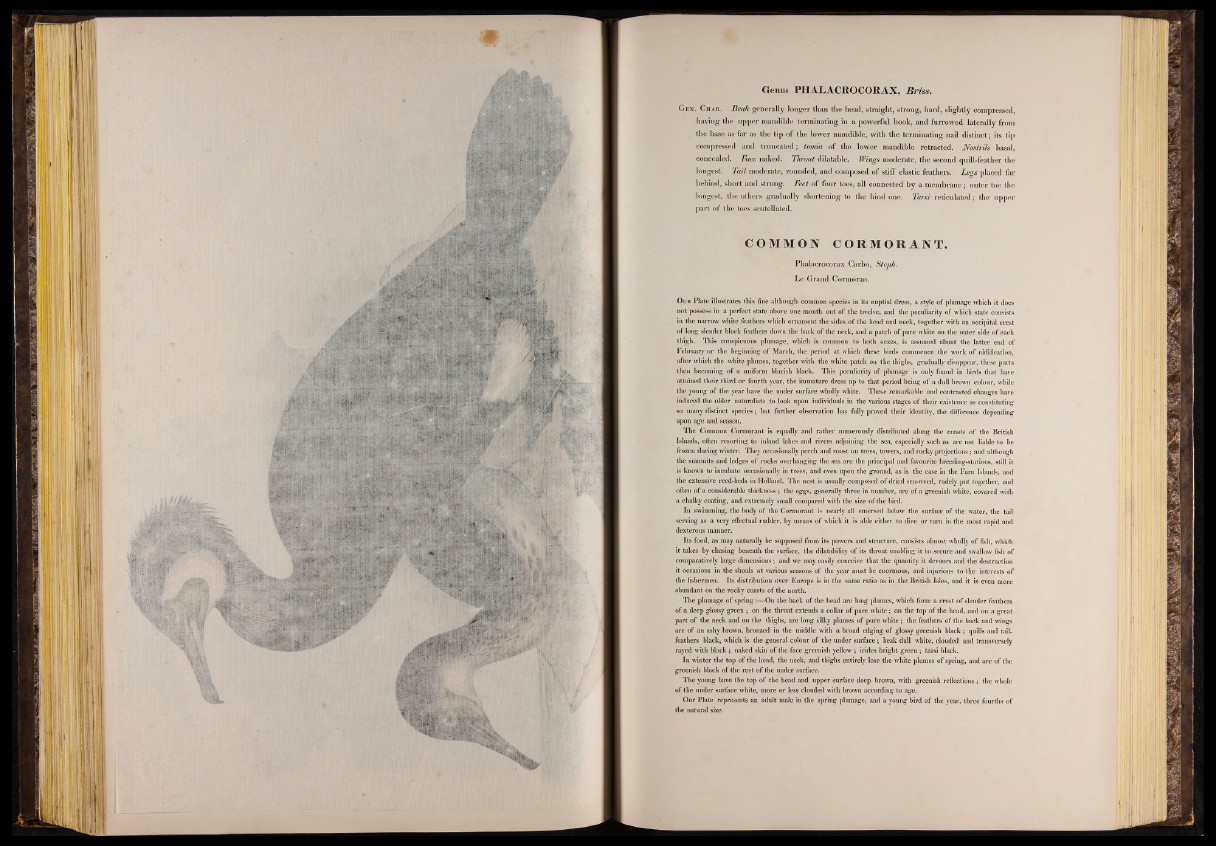
Genus PHALACROCORAX, Bras,
G e n . C har. Beak g en e ra lly lo n g e r th an th e head, stra ig h t, strong, hard , slig h tly compressed,
hav in g th e u p p e r m andible term in a tin g in a p owerful hook, an d fu rrow ed late ra lly from
th e base as fa r as th e tip o f th e low e r mandible, w ith th e term in a tin g nail d istin c t; its tip
compressed an d tru n c a te d ; tomia o f th e low e r mandible retrac ted . Nostrils basal,
concealed. Face naked. Throat dilatable. Wings moderate, th e second quill-feather the
longest. Tail m oderate, ro u n d ed , and composed o f stiff elastic feathers. Legs placed far
b eh in d , sh o rt an d stro n g . Feet o f fo u r toes, all connected b y a m em b ra n e ; o u te r toe th e
longest, th e oth ers g rad u a lly sh o rten in g to th e h ind one. Tarsi re tic u la te d ; th e u p p e r
p a r t o f th e toes scutellated.
COMMON CORMORANT.
P h a lac ro co rax Carbo, Steph.
L e G ra n d Cormoran.
Our Plate illustrates this fine although common speeies in its nuptial dress, a style of plumage which it does
not possess in a perfect state above one month out of the twelve, and the peculiarity of which state consists
in the narrow white feathers which ornament the sides of the head and neck, together with an occipital crest
of long slender black feathers down the back of the neck, and a patch of pure white on the outer side of each
thigh. This conspicuous plum&ge, which is common to both sexes, is assumed about the latter end of
February or the beginning of March, the period at which these birds commence the work of nidification,
after which the white plumes, together with the white patch on the thighs, gradually disappear, these parts
then becoming of a uniform blueish black. This peculiarity of plumage is only found in birds that have
attained their third or fourth year, the immature dress up to that period being of a dull brown colour, while
the young of the year have the under surface wholly white. These remarkable and contrasted changes have
induced the older naturalists to look upon individuals in the various stages of their existence as constituting
so many distinct species; but further observation has fully proved their identity, the difference depending
upon age and season.
The Common Cormorant is equally and rather numerously distributed along the coasts of the British
Islands, often resorting to inland lakes and rivers adjoining the sea, especially such as are not liable to be
frozen during winter. They occasionally perch and roost on trees, towers, and rocky projections; and although
the summits and ledges of rocks overhanging the sea are the principal and favourite breeding-stations, still it
is known to incubate occasionally in trees, and even upon the ground, as is the case in the Farn Islands, and
the extensive reed-beds in Holland. The nest is usually composed of dried sea-weed, rudely put together, and
often of a considerable thickness ; the eggs, generally three in number, are of a greenish white, covered with
a chalky coating, and extremely small compared with the size of the bird.
In swimming, the body of the Cormorant is nearly all emersed below the surface of the water, the tail
serving as a very effectual rudder, by means of which it is able either to dive or turn in the most rapid and
dexterous manner.
Its food, as may naturally be supposed from its powers and structure, consists almost wholly of fish, which
it takes by chasing beneath the surface, the dilatability of its throat enabling it to secure and swallow fish of
comparatively large dimensions; and we may easily conceive that the quantity it devours and the destruction
it occasions in the shoals at various seasons of the year must be enormous, and injurious to the interests of
the fishermen. Its distribution over Europe is in the same ratio as in the British Isles, and it is even more
abundant on the rocky coasts of the north.
The plumage of spring:—On the back of the head are long plumes, which form a crest of slender feathers
of a deep glossy green ; on the throat extends a collar of pure white; on the top of the head, and ou a great
part of the neck and on the thighs, are long silky plumes of pure white; the feathers of the back and wings
are o f an ashy brown, bronzed in the middle with a broad edging of glossy greenish black ; quills and tail-
feathers black, which is the general colour of the under surface; beak dull white, clouded and transversely
rayed with black ; naked skin of the face greenish yellow ; irides bright green ; tarsi black.
In winter the top of the head, the neck, and thighs entirely lose the white plumes of spring, and are of the
greenish black of the rest of the under surface.
The young have the top of the head and upper surface deep brown, with greenish reflections; the whole
of the under surface white, more or less clouded with brown according to age.
Our Plate represents an adult male in the spring plumage, and a young bird of the year, three fourths of
the natural size.